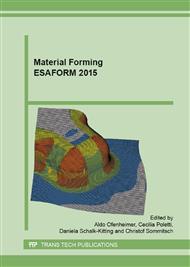p.108
p.114
p.120
p.126
p.132
p.138
p.144
p.150
p.156
High-Speed Cropping of Rods and Wire with Superposition of Various Stress Conditions
Abstract:
In the manufacturing of mass products, material and energy costs are an important part of the total costs. Competitiveness in the production of raw materials can only be maintained if waste of material is minimized and a high productivity is ensured. An outcome of these efforts is the further development of conventional cropping. High-speed cropping is characterized by the cropping speed as far as tooling is concerned. The cropping tool is accelerated up to a blade speed of 8 to 10 m/sec. This increase in cropping speed influences the surface quality of the specimens.This paper is mainly focused on the experimental investigation into the high-speed cropping in bulk metal forming. The first part of this investigation presents a comparison between conventional and high-speed cropping to demonstrate the difference between both methods. In this case study, materials of different mechanical strength are examined. The produced specimens are analysed with an optical system (GOM ATOS) to determine their geometrical properties, such as end-face flatness, ovality, and the draw-in of the specimens. The second part examines stress superposition. Here stress is superimposed on the specimens during cutting to trigger off an earlier failure of the investigated material. High-speed cropping with stress superposition is aimed at reducing the draw-in of the investigated samples. The results of this will be compared with the results of the first part to show the difference between high-speed cropping with and without stress superposition.
Info:
Periodical:
Pages:
132-137
Citation:
Online since:
July 2015
Authors:
Price:
Сopyright:
© 2015 Trans Tech Publications Ltd. All Rights Reserved
Share:
Citation:


